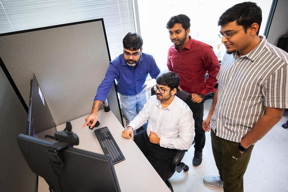Home > Press > New micromaterial releases nanoparticles that selectively destroy cancer cells
 |
Abstract:
Researchers at the Universitat Autònoma de Barcelona (UAB), in collaboration with the Sant Pau Research Institute and the CIBER-BBN, have developed micromaterials made up only of proteins, capable of delivering over an extended period of time nanoparticles that attack specific cancer cells and destroy them. The micromaterials mimic natural secretory granules found in the endocrine system and were proven effective in mouse models of colorectal cancer.
New micromaterial releases nanoparticles that selectively destroy cancer cells
Barcelona, Spain | Posted on April 5th, 2024
A team coordinated by Professor Antonio Villaverde from the Institute of Biotechnology and Biomedicine of the Department of Genetics and Microbiology, UAB, and with the participation of the Sant Pau Research Institute and the CIBER-BBN, has developed self-contained micromaterials made up only of proteins that are capable of delivering over an extended period of time the polypeptide that composes them. The technology used for the fabrication of these granules, patented by the researchers, is relatively simple and mimics the secretory granules of the human endocrine system. With regards to its chemical structure, it involves the coordination of ionic zinc with histidine-rich domain, an amino acid essential for living beings and therefore not toxic.
The new micromaterials developed by researchers are formed by chains of amino acids known as polypeptides, which are functional and bioavailable in the form of nanoparticles that can be released and targeted to specific types of cancer cells, for selective destruction.
The research team analyzed the molecular structure of these materials and the dynamics behind the secretion process, both in vitro and in vivo. In an animal model of CXCR4+ colorectal cancer, the system showed high performance upon subcutaneous administration, and how the released protein nanoparticles accumulated in tumor tissues.
“It is important to highlight that this accumulation is more efficient than when the protein is administered in blood. This fact offers an unexpected new way to ensure high local drug levels and better clinical efficacy, thus avoiding repeated intravenous administration regimens”, explains Professor Antonio Villaverde. “In the clinical context, the use of these materials in the treatment of colorectal cancer should largely enhance drug efficiency and patient’s comfort, while at the same time minimizing undesired side effects.”
Participating in the research, conducted principally by UAB researcher Julieta M. Sánchez, were researchers from the UAB Department of Genetics and Microbiology, the UAB Institute of Biomedicine and Biotechnology (IBB-UAB), and the Oncogenesis and Antitumor Drugs team led by Professor Ramón Mangues of the Sant Pau Research Institute. Both Professor Antonio Villaverde and Professor Ramón Mangues form part of the CIBER network of Bioengineering, Biomaterials and Nanomedicine (CIBER-BBN). Also participating in the study were the Protein Production Platform (Unit 1) and the Nanotoxicology Platform (Unit 18) of the Singular Infrastructure NANBIOSIS, and funding was received through several competitive research and technology transfer projects (including PID2019 -105416RB-I00/AEI/10.13039/501100011033, PDC2022-133858-I00, PID2022-136845OB-I00, CPP2021-008946, PI21/400), as well as intramural CIBER-BBN projects (VENOM4CANCER, NANOREMOTE and NANOSCAPE).
####
For more information, please click here
Contacts:
Media Contact
Octavi Lopez
Universitat Autonoma de Barcelona
Office: 34-935-813-301
Expert Contact
Antonio Villaverde
UAB
Office: +34 935813086
@UABBarcelona
Copyright © Universitat Autonoma de Barcelona
If you have a comment, please Contact us.
Issuers of news releases, not 7th Wave, Inc. or Nanotechnology Now, are solely responsible for the accuracy of the content.
| Related Links |
| Related News Press |
News and information
![]()
Simulating magnetization in a Heisenberg quantum spin chain April 5th, 2024
![]()
NRL charters Navy’s quantum inertial navigation path to reduce drift April 5th, 2024
![]()
Discovery points path to flash-like memory for storing qubits: Rice find could hasten development of nonvolatile quantum memory April 5th, 2024
![]()
Good as gold – improving infectious disease testing with gold nanoparticles April 5th, 2024
Synthetic Biology
![]()
Rice University launches Rice Synthetic Biology Institute to improve lives January 12th, 2024
![]()
The medicine of the future could be artificial life forms October 6th, 2023
Cancer
![]()
Super-efficient laser light-induced detection of cancer cell-derived nanoparticles: Skipping ultracentrifugation, detection time reduced from hours to minutes! October 6th, 2023
![]()
The medicine of the future could be artificial life forms October 6th, 2023
Possible Futures
![]()
Discovery points path to flash-like memory for storing qubits: Rice find could hasten development of nonvolatile quantum memory April 5th, 2024
![]()
With VECSELs towards the quantum internet Fraunhofer: IAF achieves record output power with VECSEL for quantum frequency converters April 5th, 2024
Nanomedicine
![]()
Good as gold – improving infectious disease testing with gold nanoparticles April 5th, 2024
![]()
Researchers develop artificial building blocks of life March 8th, 2024
Discoveries
![]()
Chemical reactions can scramble quantum information as well as black holes April 5th, 2024
![]()
Utilizing palladium for addressing contact issues of buried oxide thin film transistors April 5th, 2024
![]()
Good as gold – improving infectious disease testing with gold nanoparticles April 5th, 2024
Announcements
![]()
NRL charters Navy’s quantum inertial navigation path to reduce drift April 5th, 2024
![]()
Discovery points path to flash-like memory for storing qubits: Rice find could hasten development of nonvolatile quantum memory April 5th, 2024
Interviews/Book Reviews/Essays/Reports/Podcasts/Journals/White papers/Posters
![]()
Simulating magnetization in a Heisenberg quantum spin chain April 5th, 2024
![]()
Discovery points path to flash-like memory for storing qubits: Rice find could hasten development of nonvolatile quantum memory April 5th, 2024
Nanobiotechnology
![]()
Good as gold – improving infectious disease testing with gold nanoparticles April 5th, 2024
![]()
Researchers develop artificial building blocks of life March 8th, 2024
- SEO Powered Content & PR Distribution. Get Amplified Today.
- PlatoData.Network Vertical Generative Ai. Empower Yourself. Access Here.
- PlatoAiStream. Web3 Intelligence. Knowledge Amplified. Access Here.
- PlatoESG. Carbon, CleanTech, Energy, Environment, Solar, Waste Management. Access Here.
- PlatoHealth. Biotech and Clinical Trials Intelligence. Access Here.
- Source: http://www.nanotech-now.com/news.cgi?story_id=57470
- :has
- :is
- :not
- $UP
- 1
- 10
- 12th
- 4
- 5th
- 6th
- 7
- 7th
- 8th
- a
- access
- Accumulated
- accumulation
- accuracy
- Achieves
- addressing
- administered
- administration
- advanced
- against
- allen
- also
- an
- analyzed
- and
- animal
- April
- ARE
- artificial
- AS
- At
- attack
- avoiding
- barcelona
- BE
- behind
- beings
- Better
- bind
- biology
- Biomaterials
- biotechnology
- Black
- Blocks
- blood
- both
- Brazilian
- Building
- by
- CAN
- Cancer
- Cancer cells
- capable
- carbon
- Cells
- Center
- CGI
- chains
- chan
- Changes
- chemical
- click
- Clinical
- collaboration
- COM
- comfort
- comment
- competitive
- conducted
- contact
- content
- context
- contribution
- conventional
- coordinated
- coordination
- cost-effective
- could
- critical
- de
- December
- del
- delivering
- delivery
- Department
- Design
- destroy
- Detection
- develop
- developed
- Development
- Devices
- discover
- Disease
- domain
- dramatically
- drug
- Drugs
- dynamics
- Effective
- effects
- efficacy
- efficiency
- efficient
- end
- enhance
- ensure
- essential
- Ether (ETH)
- Explains
- extended
- fact
- Film
- Find
- findings
- For
- form
- formed
- formulation
- found
- Frequency
- from
- functional
- funding
- future
- generating
- Genetics
- gif
- Gold
- Hardware
- Have
- Health
- her
- High
- Highlight
- HOURS
- How
- HTML
- http
- HTTPS
- Hub
- human
- if
- important
- improve
- improving
- in
- Inc.
- Including
- inexpensive
- infectious
- inflammation
- information
- Infrastructure
- Initiative
- Institute
- Internet
- into
- intravenous
- involves
- involving
- Ionic
- issues
- IT
- ITS
- January
- jpg
- known
- largely
- laser
- launched
- launches
- Led
- levels
- Life
- links
- living
- local
- made
- make
- March
- materials
- medicine
- Memory
- method
- microbiology
- million
- minimizing
- model
- models
- molecular
- more
- more efficient
- mouse
- mRNA
- Nanomedicine
- nanotechnology
- Natural
- Navigation
- net
- network
- New
- news
- novel
- now
- october
- of
- Offers
- on
- only
- optical
- or
- output
- over
- palladium
- pandemic
- part
- participating
- participation
- patented
- path
- performance
- period
- PHP
- platform
- plato
- Plato Data Intelligence
- PlatoData
- please
- points
- Post
- posted
- power
- press
- Press Release
- process
- producing
- Production
- Professor
- projects
- prompts
- protection
- Protein
- Proteins
- proved
- proven
- Quantum
- Quantum Frequency
- quantum information
- Quantum Internet
- qubits
- reactions
- received
- receives
- record
- recording
- reduce
- Reduced
- reduces
- regards
- relatively
- release
- released
- Releases
- repeated
- research
- researcher
- researchers
- responsible
- return
- reveal
- Rice
- same
- Save
- Search
- secrets
- selective
- Sensitivity
- sensors
- several
- Share
- should
- showed
- Shows
- side
- significant
- Simple
- singular
- solely
- Spain
- specific
- Spin
- start
- storing
- structure
- Study
- subcutaneous
- submit
- synthetic
- system
- targeted
- team
- Technologies
- Technology
- tested
- Testing
- tests
- than
- that
- The
- The Future
- Them
- therefore
- These
- thin
- this
- Through
- Thus
- time
- tissues
- to
- together
- toronto
- towards
- toxic
- transfer
- treatment
- tumor
- TURN
- types
- Unexpected
- unit
- university
- university of washington
- unlock
- unlocks
- upon
- us
- use
- used
- Vaccine
- vivo
- was
- washington
- Wave
- Way..
- WELL
- were
- when
- which
- while
- will
- with
- Yahoo
- you
- zephyrnet
- Zuckerberg





















